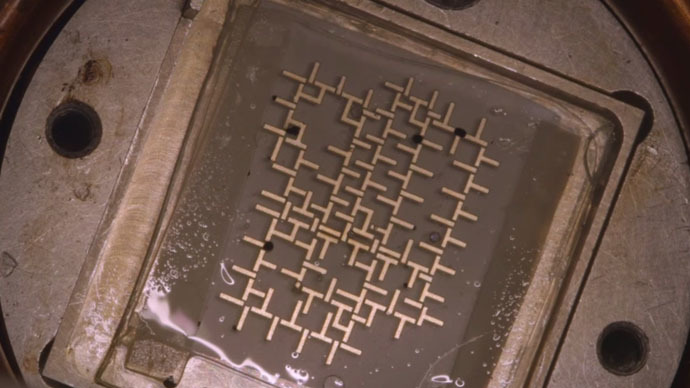Engineers develop computer operating on water droplets (VIDEO)

Stanford bioengineers have developed a synchronous processor based on moving water droplets instead of electrons. The result of a decade of work, the machine belongs to a whole new class, based on manipulating physical matter, instead of information.
Manu Prakash, an assistant professor of bioengineering at Stanford, and his students have applied the physics of moving water droplets to the operating clock, which is a core element in computer science, responsible for the synchronization of all operations. The team published their results on Monday, in the recent edition of Nature Physics.
“In this work, we finally demonstrate a synchronous, universal droplet logic and control,” Prakash said in the press release.
In theory the new computer would be able to perform the same operations as a common electronic computer, although much slower. But the computation speed is not the goal, as the team was aiming at manipulating physical materials instead of bits of information.
“We already have digital computers to process information. Our goal is not to compete with electronic computers or to operate word processors on this,” Prakash said. “Our goal is to build a completely new class of computers that can precisely control and manipulate physical matter.”
“Imagine if when you run a set of computations where not only information is processed but physical matter is algorithmically manipulated as well. We have just made this possible at the mesoscale,” he explained.
The brand-new computer “chip” is based on a rotating magnetic field, and a kind of a glass maze for tiny individual droplets infused with magnetic nanoparticles. Each rotation of the field moves droplets in a predetermined direction – all at once but one step each cycle. The presence of a droplet stands for 1 in a binary code.
READ MORE: Uploading human brain for eternal life is possible – Cambridge neuroscientist
The current first generation chips are already minuscule – half the size of a postage stamp – while the droplets are smaller than poppy seeds, according to the scientists.
“The actual design space in our platform is incredibly rich. Give us any Boolean logic circuit in the world, and we can build it with these little magnetic droplets moving around,” Georgios "Yorgos" Katsikis, who is the first author on the paper, said.
The work is so fundamental and yet simple that apart from its most obvious use – as a chemical or biological laboratory, – it could lead to the exploration of the physics of computation becoming common.
“We're very interested in engaging anybody and everybody who wants to play, to enable everyone to design new circuits based on building blocks we describe in this paper or discover new blocks,” Prakash said. “Right now, anyone can put these circuits together to form a complex droplet processor with no external control – something that was a very difficult challenge previously.”












